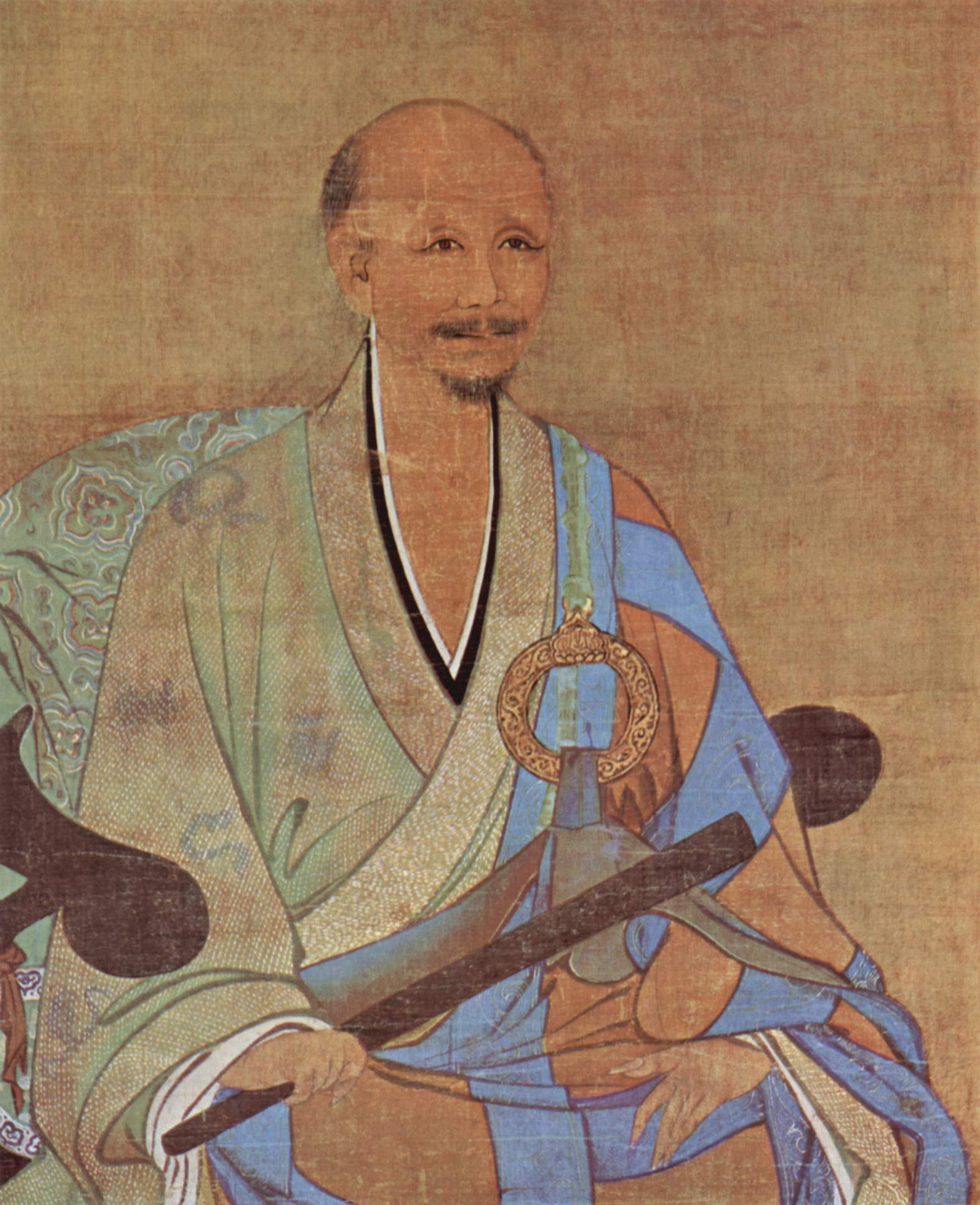- Wuzhun Shifan
Infobox Buddhist biography
name = Wuzhun Shifan

img_size =
img_capt = Portrait of Zen master Wuzhun Shifan, painted in 1238 AD,Song Dynasty .
landscape =
birth_name =
other_names =
dharma_name =
birth_date = 1178
birth_place =Sichuan Province ,China
death_date = 1249
death_place =
nationality = Chinese
denomination =Ch'an
school =
lineage =
title =Ch'an-shih
workplace =
education =
occupation =
teacher =
reincarnation_of =
predecessor =
successor =
student =
spouse =
partner =
children =
website =Wuzhun Shifan ( _zh. 無準師範;
Wade-Giles : Wu Chun Shih Fan; 1178–1249 AD) was a Chinese painter, calligrapher, and prominentZen Buddhist monk who lived during the lateSong Dynasty (960-1279).Life
Wuzhun Shifan was born in
Zitong ,Sichuan province, China. He eventually became a renowned Buddhistabbot at the Temple of MountJingshan . He was once summoned byEmperor Lizong of Song (理宗; r. 1224-1264) in 1233 in order to share with him the doctrine of Chán (Zen) Buddhism, discussingDharma with the emperor.Faure, 43.] For this Wuzhun was given the title "Fojian Yuanzhao Chanshi" (Mirror of the Buddha, Zen Teacher) as well as a gold-embroidered kaśaya that he wears in his portrait painting of 1238.Wuzhun had many
disciple s who studied under him. This includedEnni Ben'en (圓爾辯圓 ; 1201-1280; Shoichi Kokushi), who studied under Wuzhun in China from 1235 to 1241 and later brought Wuzhun's teachings toJapan . Afterwards, Enni helped cement greater acceptance for Zen teaching in Japan and aided in the establishment of theTōfuku-ji temple ofKyoto in 1243.Calligraphy and artwork
Some of Wuzhun's written
calligraphy that was handed down to Enni is still preserved on plaques found at Tōfuku-ji, and a scroll of Wuzhun's calligraphy was even presented to the Tokugawa family as a gift to theShogun . There is also a [http://www.tnm.go.jp/en/servlet/Con?processId=00&ref=2&Q1=&Q2=&Q3=&Q4=________512__&Q5=&F1=&F2=&pageId=E15&colid=TB1174 written letter] of Wuzhun Shifan, dated to 1242, that is now preserved as a national treasure of calligraphy at theTokyo National Museum .Wuzhun Shifan's written inscription appears on the 13th century
Chinese painting "A Monk Riding a Mule", housed in the Collection of John M. Crawford Jr.Embree, 113.] It is possible that he painted the picture, although it is unknown if he is the true author of the artwork.Wuzhun's portrait was painted in 1238 by an anonymous artist, taken to Japan by Enni Ben'en in 1241, and is still located at Tōfuku-ji in Kyoto, Japan. [The Yorck Project: 10.000 Meisterwerke der Malerei. DVD-ROM, 2002. ISBN 3936122202. Distributed by DIRECTMEDIA Publishing GmbH.] Lauer, 31.] The painting also bears an inscription penned by Wuzhun Shifan. Bernard Faure writes that it is painted in the Chan priest portrait style, known as "dingxiang" or "zhenxiang" (Japanese: "chinzō"). Like others of its style, the Chan monk sits in a lotus posture, donning in full monastic robes, with the monk's shoes placed at a footstool below and his right hand grasping a whisk or staff.Faure, 43–44.]
ee also
*
History of the Song Dynasty
*List of Chinese people
*Culture of the Song Dynasty
*Chinese Buddhism
*Buddhist art Notes
References
*Embree, Ainslie Thomas (1997). "Asia in Western and World History: A Guide for Teaching". Armonk: ME Sharpe, Inc.
*Faure, Bernard. (2003). "Chan Buddhism in Ritual Context". New York: RoutledgeCurzon. ISBN 0415297486.
*Lauer, Uta. (2002). "A Master of His Own". Stuttgart: Steiner. ISBN 3515079327.External links
* [http://www.moaart.or.jp/english/art/calligraphy0001.html MOA Museum of Art]
* [http://www.tnm.go.jp/en/servlet/Con?pageId=E09&processId=00&ref=2&start=1&Q4=________512__ Tokyo National Museum]
Wikimedia Foundation. 2010.
